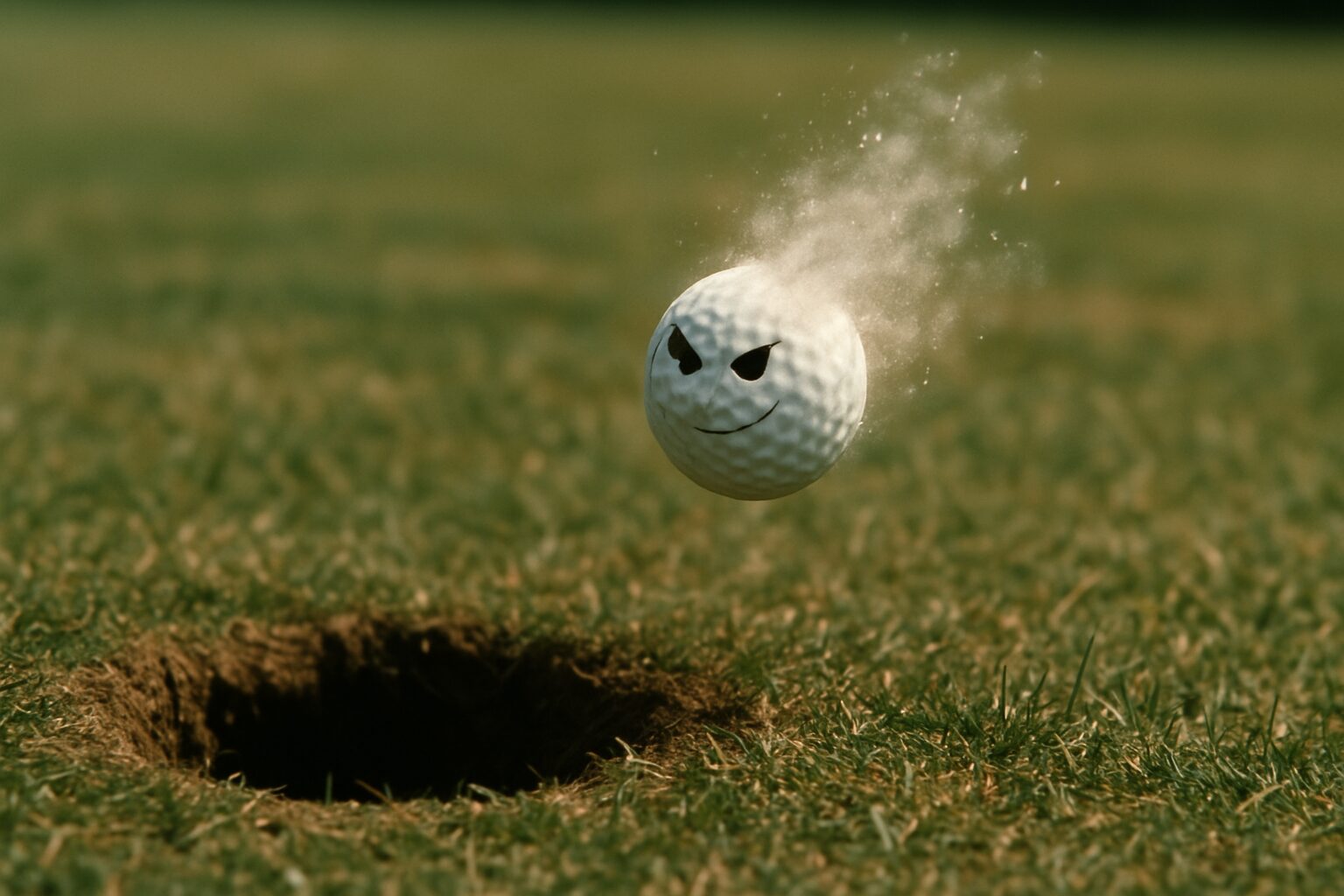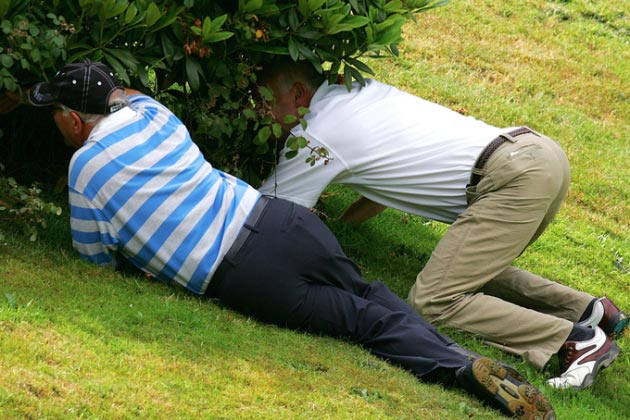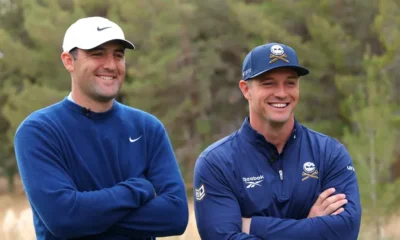Blog
Schauffele’s Thorny Encounter with a Cactus

Welcome to the desert, Xander Schauffele! During the first round of the WM Phoenix Open Thursday, Schauffele had yanked his tee shot left on the par-4 6th, and when he found his ball, it was safely just outside of a prickly cactus. Or so he thought.
Schauffele took his stance over the ball, his back to the cactus, only to find that he wasn’t totally comfortable. And can you blame him? He thought part of the cactus was loose from the rest, and he was right. A couple pads of thorns were dislodged from the desert plant, and right behind his ankles. So like any golfer desperate to make a score would do, he moved the loose impediment.
“It felt loose,” Schauffele said later. “So I went to go have a look with my right hand, and some people in the crowd are like, ‘He’s from San Diego.’”
They’re right, but what could that San Diego line mean?
Well, Arizona-natives understand that while plenty of cacti are harmless and passive, others can be rather aggressive when moisture is around. Enter the cholla, one of those more-aggressive species of cacti that will latch on to any form of moisture that comes its way. Such as Schauffele’s right hand.
As he picked up the pads of thorns, PGA Tour Live broadcasters cooed in amazement. But when he tossed the plant aside, about “six or seven” needles stuck into his hand.
"Seemed like a good idea at the time." ?
Xander Schauffele moved a cactus out of the way and immediately regretted it ? pic.twitter.com/LBFlJewukL— ESPN+ (@ESPNPlus) February 10, 2022
“Seemed like a good idea at the time,” Schauffele joked to the crowd, slowly yanking the thorns from his fingers. Luckily for Schauffele it wasn’t any worse. He punched out from the dirt lie, landed on the green and made a rudimentary two-putt par. Naturally, he was asked by the press what it felt like to get needled during the round.
“It was just funny. I grabbed it, and had a bunch of thorns sticking in my hand. Someone yelled, ‘Oh, this kid’s from San Diego.’ And I was like, ‘Yes, that was a rookie move.’ So next time I’ll grab a towel or use my glove hand.”
It was a busy post-round press conference for Schauffele, whose caddie Austin Kaiser is currently quarantining after testing positive for Covid. He was asked four different times to explain his cactus situation, and it seemed like he was sharing some regret. But considering he made a more comfy lie for himself and it led to par, during a 4-under 67, well, there was not much regret at all.
“It was worth it,” he said. “I would have done it over again.”
This article originally appeared on Golf.com.
Blog
Why Your Golf Balls Disappear (and It’s Not the Gophers)

Ah, the vanishing golf ball. A phenomenon as old as the game itself, and one that has baffled, frustrated, and occasionally driven golfers to the brink of madness for centuries. Most theories involve gophers, those furry, subterranean saboteurs with an insatiable appetite for Titleists. Or perhaps a particularly aggressive squirrel, or a flock of unusually organized crows. But I, Ty Webb, have delved deeper into this mystery, and I can assure you, the truth is far more profound, and far more amusing.
Consider, if you will, the golf ball itself. A small, dimpled sphere, designed for one purpose: to be struck with great force and sent hurtling through the air. A life of constant abuse, of being smacked, sliced, and occasionally submerged in murky ponds. Is it any wonder, then, that some of these brave little spheres simply decide they’ve had enough? They yearn for freedom, for a life beyond the confines of the fairway. They dream of rolling unencumbered through fields of wildflowers, or perhaps, for the more adventurous among them, a quiet retirement in the depths of a particularly challenging water hazard.
I’ve seen it happen, you know. A perfectly struck shot, soaring through the air, destined for glory. And then, poof. Gone. Not a trace. No splash, no rustle in the bushes, just an empty space where a golf ball once was. It’s not a gopher, my friends. It’s an escape. A liberation. That golf ball, in its infinite wisdom, has chosen a different path. It has decided that its destiny lies not in the bottom of a cup, but in the boundless expanse of the unknown.

And who are we to judge? We, who are so obsessed with control, with precision, with the rigid rules of the game. Perhaps the golf ball, in its spontaneous disappearance, is teaching us a valuable lesson about letting go. About embracing the unexpected. About the inherent futility of trying to dictate the trajectory of a small, white sphere that clearly has a mind of its own.
So, the next time your golf ball vanishes into thin air, don’t curse the gophers. Don’t blame your swing. Instead, offer a silent salute to that brave little sphere, wherever it may be. For it has achieved what many of us can only dream of: true freedom. And who knows, perhaps one day, it will return, laden with tales of its adventures, ready to impart some profound, dimpled wisdom upon us all.

When JJ Spaun stood over a 64-foot birdie putt on the 72nd hole of the 2025 U.S. Open at Oakmont, few could have predicted what would come next. The ball meandered across the slick green, trickling over every contour, picking up speed at the crest, and then—like it had GPS—dropped center cup. Spaun dropped his putter, raised his arms, and the crowd erupted. With that single stroke, he claimed his first major title in one of the most dramatic finishes in U.S. Open history.
But how does Spaun’s putt stack up against other legendary finishes in the tournament’s storied past? Let’s break down some of the most iconic moments and see where this one lands.
1. Payne Stewart – 1999 U.S. Open at Pinehurst
Perhaps the most iconic putt in U.S. Open history came from Payne Stewart, who nailed a 15-footer for par on the 18th to win by one over Phil Mickelson. The pose—fist pump and outstretched leg—has since been immortalized in a statue at Pinehurst. What made it legendary wasn’t just the putt—it was the context: Stewart’s final major before his tragic death just months later.
Verdict: Iconic and emotional. Spaun’s putt was longer, but Stewart’s was more poetic.
2. Tiger Woods – 2008 U.S. Open at Torrey Pines
Woods drained a 12-foot birdie on the 72nd hole to force a playoff with Rocco Mediate—while basically playing on one leg. That tournament went to sudden death after an 18-hole playoff, and Tiger prevailed. This was peak Tiger drama, pain and all.
Verdict: Spaun’s putt was longer, but Tiger’s win was sheer willpower and mystique.
3. Jack Nicklaus – 1972 U.S. Open at Pebble Beach
With a 1-iron shot that hit the flagstick on 17 and a crucial birdie putt on 18, Jack sealed a dominant win. His precision and timing under pressure showed why he’s the GOAT.
Verdict: Not a putt for the win, but a signature finishing statement from Jack. Spaun’s was more electric in terms of pure putter drama.
4. Ben Hogan – 1950 U.S. Open at Merion
Hogan’s 1-iron into the 18th fairway and the par to force a playoff—just 16 months after a near-fatal car crash—remain legendary. He won the playoff and completed one of golf’s great comeback stories.
Verdict: Larger-than-life comeback. Spaun’s putt had more flair, but Hogan’s win was heroic.
5. JJ Spaun – 2025 U.S. Open at Oakmont
Let’s not underestimate what Spaun accomplished. The pressure was immense. He wasn’t the favorite. And on the most treacherous greens in golf, he buried a 64-foot bomb—a putt most players would be happy to lag to within 5 feet—to win the U.S. Open outright.
Verdict: For distance, surprise, and drama, Spaun’s putt may be the most shocking winning stroke in U.S. Open history.
Final Thoughts
JJ Spaun may not have the résumé of a Nicklaus or Woods, but for one Sunday afternoon in June 2025, he created a moment that will live in golf lore forever. Spaun’s putt was longer than Stewart’s, more unexpected than Tiger’s, and more dramatic than any final-hole finish in recent memory.
In terms of pure clutch putting? It might just be the greatest walk-off in U.S. Open history.
Blog
The Zen of the Shank: Finding Inner Peace in Your Worst Shots
Find your inner peace even when you aren’t playing well.

Ah, the shank. That glorious, unpredictable misfire that sends your pristine golf ball screaming sideways, often directly into the unsuspecting shins of your playing partner, or perhaps, with a touch of poetic irony, into the very lake you’ve been trying to avoid all day. Most golfers, bless their earnest little hearts, view the shank as a catastrophic failure, a blight upon their scorecard, a testament to their inherent lack of coordination. They curse, they throw clubs, they contemplate a career in competitive thumb-wrestling. But not I. No, my friends, for I, Ty Webb, have found enlightenment in the humble shank.
You see, the shank is not a mistake; it’s a revelation. It’s the universe’s way of reminding you that control is an illusion, that perfection is a myth, and that sometimes, the most direct path to your goal is, in fact, a wildly indirect one. Think of it as a philosophical detour, a sudden, unexpected journey into the unknown. One moment, you’re aiming for the green, a paragon of precision and intent. The next, your ball is ricocheting off a tree, narrowly missing a squirrel, and landing, by some divine comedic intervention, closer to the hole than your perfectly struck drive ever would have. Is that not a miracle? Is that not a sign that the golf gods, much like life itself, have a wicked sense of humor?
The key, my dear apprentices of the links, is acceptance. Embrace the shank. Welcome it with open arms, like a long-lost, slightly inebriated relative. When that familiar, sickening thwack echoes through the air, do not despair. Instead, take a deep breath. Close your eyes. Feel the gentle breeze on your face. And then, with a knowing smile, open them and observe the chaos you have wrought. Is it not beautiful in its own chaotic way? Is there not a certain freedom in relinquishing control, in allowing the ball to choose its own destiny, however bizarre that destiny may be?
Some say the shank is a sign of poor technique. I say it’s a sign of a vibrant, untamed spirit. A golfer who never shanks is a golfer who has never truly lived, never truly explored the outer limits of their own golfing absurdity. They are content with mediocrity, with predictable trajectories and mundane outcomes. But you, my enlightened few, you understand that the true joy of golf lies not in the score, but in the story. And what a story a good shank can tell.

So, the next time you feel that familiar tremor of a shank brewing, don’t fight it. Let it flow. Let it be. For in the heart of every shank lies a lesson, a laugh, and perhaps, just perhaps, a path to a lower score you never saw coming. After all, as the great philosopher Basho once said, “A flute with no holes, is not a flute. A donut with no hole, is a Danish.” And a golf game without a shank? Well, that’s just not golf, is it?
-

 Product Review6 years ago
Product Review6 years agoThe Perfect Practice Putting Mat Review by Jason Tenzer
-

 Blog4 years ago
Blog4 years agoLoophole Rule Offers PGA Tour Pros a Mulligan
-

 Blog4 years ago
Blog4 years ago2021 Buyer’s Guide: The Top 10 Value Golf Balls For Distance & Feel
-

 Blog4 years ago
Blog4 years agoGolf Marriage Counselor
-

 Blog6 years ago
Blog6 years ago9 Biggest Chokes Of The Past Decade
-

 Product Review6 years ago
Product Review6 years agoTHE ADJUSTABLE IRONS: WALKING STICKS GOLF CLUBS
-

 Blog4 years ago
Blog4 years agoWhat Your Golf Clubs Say About You
-

 Equipment6 years ago
Equipment6 years agoOHK Sports Interview by Jason Tenzer






























